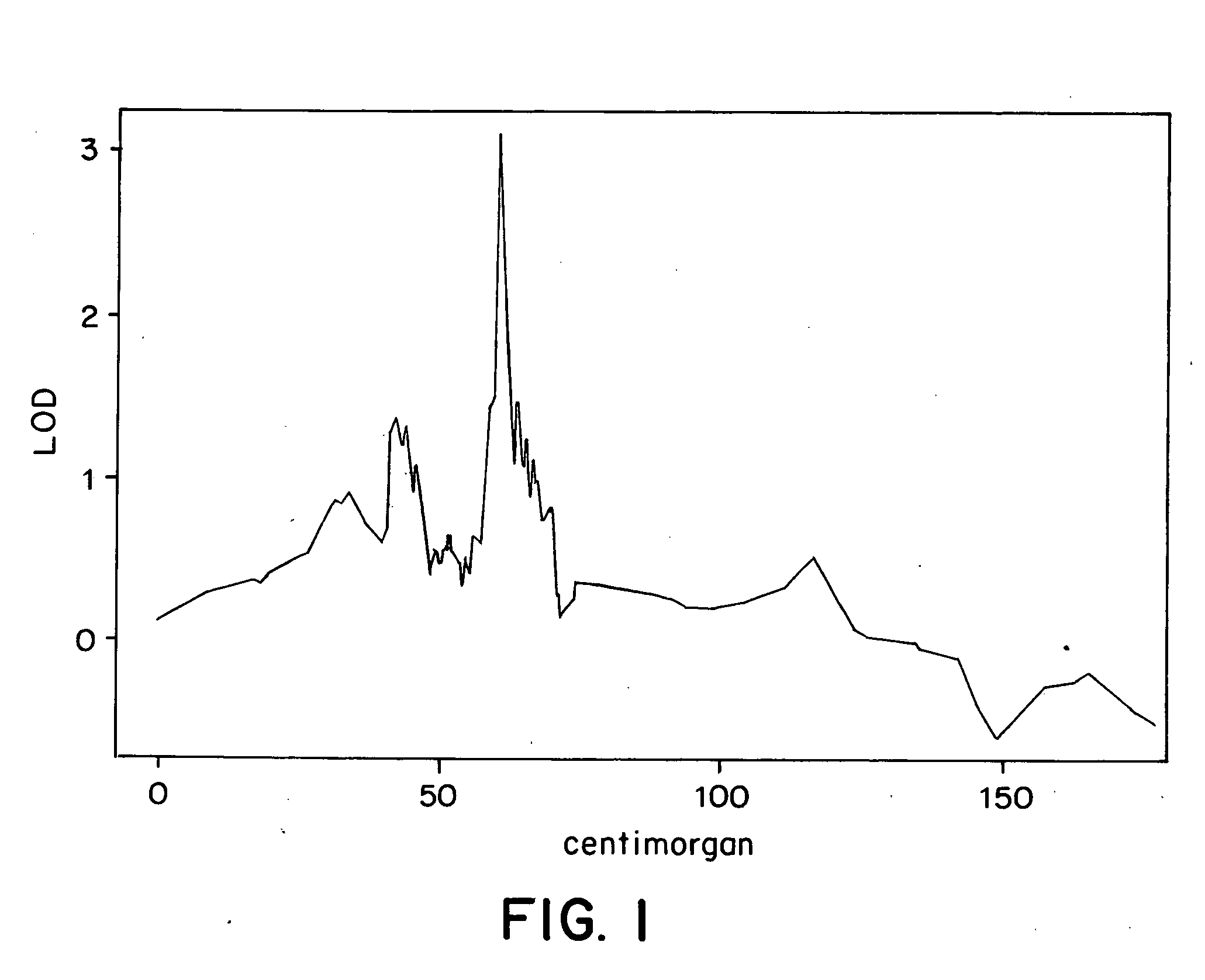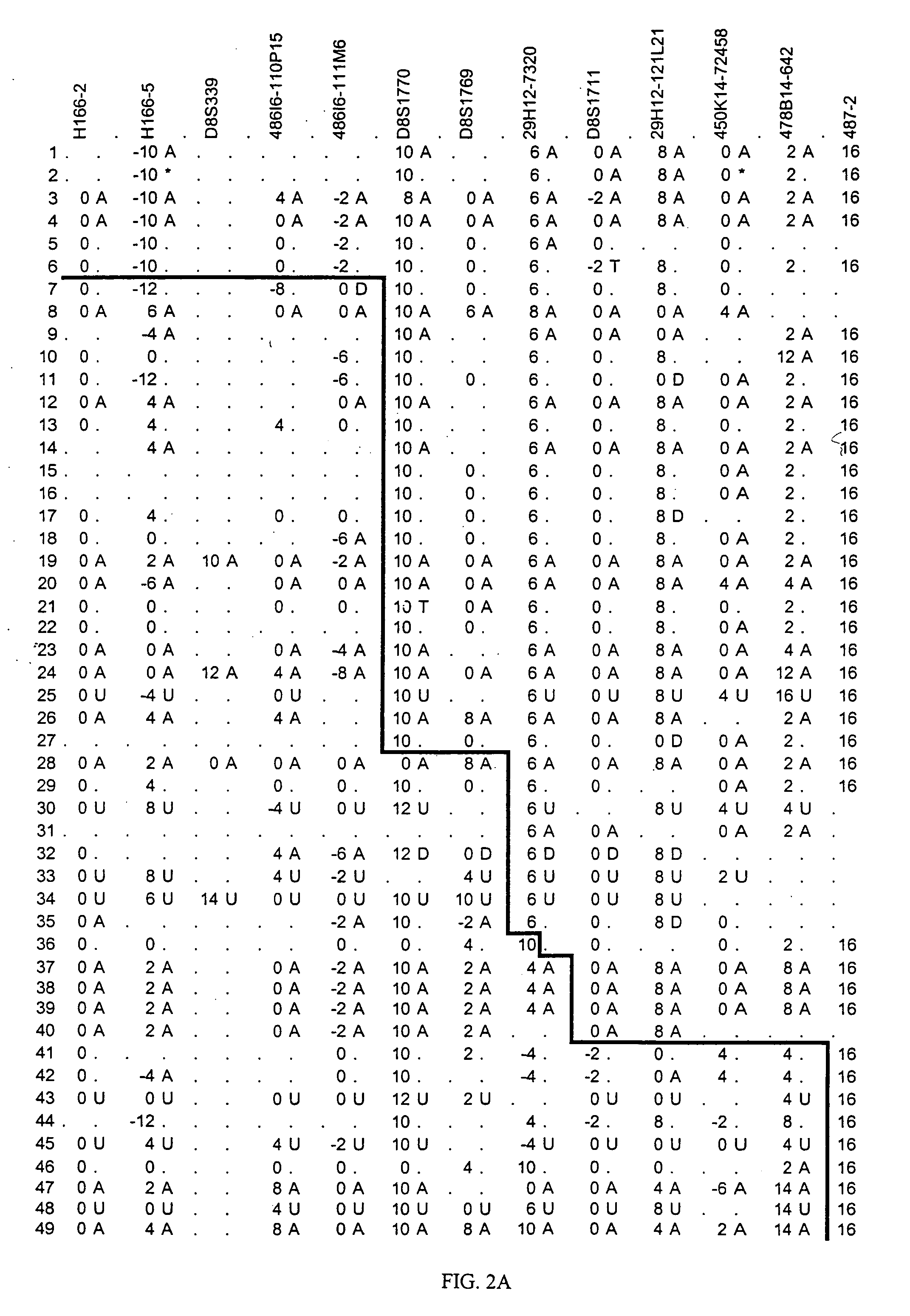Human schizophrenia gene
a human and gene technology, applied in the field of human schizophrenia gene, can solve the problems of uncertain transmission mode, and achieve the effect of altering the activity of expression of an nrg1 polypeptid
- Summary
- Abstract
- Description
- Claims
- Application Information
AI Technical Summary
Benefits of technology
Problems solved by technology
Method used
Image
Examples
example 1
Identification of Gene with Linkage to Schizophrenia
[0169] The lifetime expectancy of schizophrenia in Iceland is similar to what has been observed in the neighboring countries, 0.6% for males and 0.9% for females. A team of seven psychiatrists who diagnose patients and confirm the diagnosis of previously diagnosed schizophrenics and collect samples was employed. Each psychiatrist interviewed, using the Schedule for Schizophrenia and Affective Disorders, lifetime version (SADS-L) (Endicott, J. and Spitzer, R. L., Arch. Gen. Psychiatry 35:837 (1978)). The information from the SADS-L interviews was then used to classify all cases in accordance with research diagnostic criteria (RDC) and the Diagnosis and Statistical Manual of Mental Disorders, third edition, revised (DMS III-R). Furthermore, the operational criteria OPCRIT checklist for psychotic illness was also used to facilitate a polydiagnostic approach to psychotic illness (McGuffin, P. et al., Arch. Gen Psy...
example 2
Behavioral Testing of NRG1 and ErbB4 Mutant Mice
[0204] Male NRG1TM hypomorphs, ErbB4 hypomorphs and litter-mate controls for each line were bred at Charles River Laboratories USA by crossing to a C57B16 background. They were shipped to the testing laboratory at PsychoGenics Inc. NY, USA (six weeks prior to behavioral testing) where they were housed in groups of 3-5 related mice per cage. The open field study was conducted when the male mice were 5 to 6 months of age. Group housed mice were brought into the experimental room and allowed to acclimate for one hour prior to testing. Each mouse was placed for 30 minutes in a square open field box (17×17×12 inch). Up to eight animals were tested at one time, one animal in each of eight arenas, under low lighting conditions (provided by a 15 watt red lamp). The automated infrared beam array system measured locomotion in the center and periphery of the test arena. Activity data were collected in 5 min intervals over the 30 min open field ...
example 3
ErbB4 As a Target
[0212] Neuregulin (NRG) signals through a receptor tyrosine kinase family known as the ErbB receptors. The four different receptors (ErbB1-4) that belong to this family all have high protein sequence homology. The NRG1 gene binds to either ErbB3 or ErbB4 leading to homo- (ErbB3 / 3, ErbB4 / 4) or heterodimer (ErbB2 / 3, ErbB2 / 4) formation. Since ErbB3 has a defective kinase domain, only the ErbB2 / 3 heterodimer mediates signalling. Dimerization of ErbB4 caused by ligand binding leads to tyrosine phosphorylation of the receptor by its partner on four sites. Of these three sites, Y1056, Y1188 and Y1242 have been identified as docking sites for the SH2 domain containing proteins Shc (Y1188 and Y1242) and P13 kinase (Y1056). Recruitment of these proteins leads to propagation of the NRG1 signal trough their respective signalling pathways followed by biological response.
[0213] NRG acts as a trophic factor for neurons and glia and regulates the expression of genes important fo...
PUM
| Property | Measurement | Unit |
|---|---|---|
| Frequency | aaaaa | aaaaa |
Abstract
Description
Claims
Application Information
 Login to View More
Login to View More - R&D
- Intellectual Property
- Life Sciences
- Materials
- Tech Scout
- Unparalleled Data Quality
- Higher Quality Content
- 60% Fewer Hallucinations
Browse by: Latest US Patents, China's latest patents, Technical Efficacy Thesaurus, Application Domain, Technology Topic, Popular Technical Reports.
© 2025 PatSnap. All rights reserved.Legal|Privacy policy|Modern Slavery Act Transparency Statement|Sitemap|About US| Contact US: help@patsnap.com



